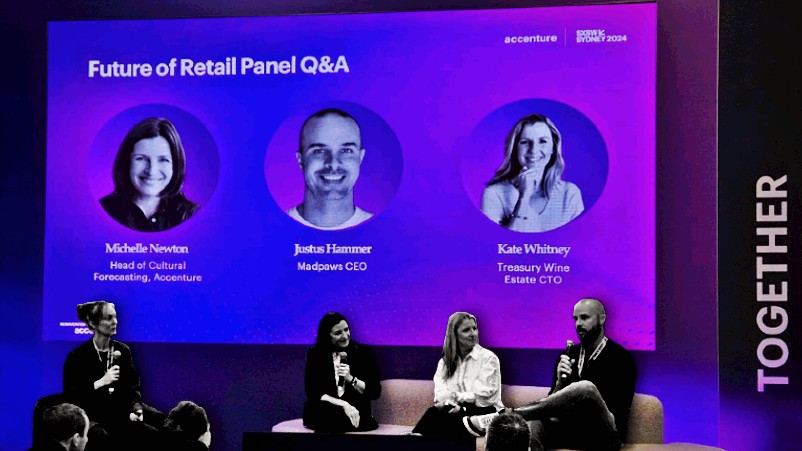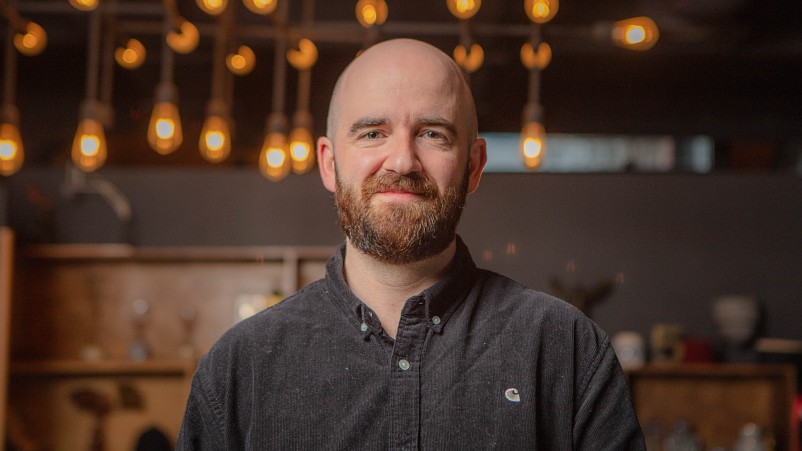Penfolds Grange redesign for young rich set pays off; Mad Paws slips pets between the sheets – the data, macro trends and loyalty powering retail CX rethink

There were audible gasps when the Treasury Wine Estates board saw the first non-red Penfolds Grange gift box designed by creative collaborator, Japanese artist, Nigo, earmarked for the ever-younger luxury market. But as chief data and technology officer, Kate Whitney, points out, all the consumer insights, demand zone mapping, consumption occasion trends, moments and retail markers make it plain: Disrupting the wine category by building cultural credibility and meeting changing retail experience expectations is critical if Penfolds is to win against declining wine preferences. The former CMO joined Mad Paws CEO, Justus Hammer, plus FiftyFive5 head of cultural forecasting, Michelle Newton, to debate the facets of future retail and changing consumer views of value on a panel at the recent SXSW Sydney event.
New world
Switching up the vernacular at Treasury Wine Estates from ‘direct-to-consumer’ to ‘direct-to-collector’ has been transformative in how the business thinks about the growing youth luxuriant segment for Penfolds, according to data and technology chief, Kate Whitney. And it’s a vital step if the wine producing giant can course correct against declining consumption of wine, notably across younger audiences.
“We have an executive which supports each other in making some brave, bold decisions. I think in our heart, we also know we’ve got to do something different to get something different,” Whitney said on an Accenture panel during SXSW Sydney. According to Treasury’s FY24 financials, revenue overall was up 12.9 per cent to $2.8bn, but commercial wine sales were decidedly down and resulted in a $300m impairment of the Treasury Premium Brands division.
“It’s no secret: Open the paper and you’ll read the wine category is not having the best time right now. We had to disrupt our own category in order to get some wins. Penfolds is certainly the jewel in our crown, and it's the one brand that could probably survive this and has the credibility for it globally,” said Whitney.
Young wine
Treasury won’t do much without testing, however, or robust data set. But all the data pointed to going hard for the new-look, younger high net worth audiences.
“Think about a 30-year-old who has high disposable income, extremely good taste, and centres their spend towards fashion and aesthetic,” Whitney continued. “According to the research and data, they also happen to spend a decent amount of money on going out, and particularly on wine, as well as brands that have credentials.
“How do you take a very old, traditional brand and make it relevant again? You can do it through beautiful assets and things like that. Or what a lot of the houses are doing, which is turning towards a collaboration with a really iconic, well known, trusted, credible content creators.”
Hence Treasury’s brave bet to strike a new kind of creative collaboration partnership with Japanese musician, designer and artist, Nigo, under the headline Discover ONE, by Penfolds. According to Whitney, it’s paying off.
But giving Nigo “a bit of free rein with the brand” hasn’t come without raised eyebrows – or in this case, audible gasps in the boardroom when the team was first confronted with a decidedly different design aesthetic for its iconic Penfolds Grange, Whitney admitted.
“We bravely let Nigo have a go at the gift box. You can’t touch the Grange bottle, so don't worry, that stays sacrosanct to the brand. But we enabled Nigo to have a have a look at how you would box that wine for the holidays and for a new luxuriant in Asia. The question was: How would you box that wine if it was a brand-new SKU made in China for China? It was such an interesting experiment. There were gasps in the boardroom when they saw the design. There are people who still can't really quite get over it.”
Examples include the Holiday series Bin 389 (AKA 'Baby Grange') available in Nigo designed boxes that feature art graphic symbolising eternity and longevity.
“You can see the wine industry thinking hang on a minute, the handbag brands do that, that’s not the wine brands. But we're really putting ourselves in that luxury segment and gaining that cultural credibility,” Whitney said.
In addition, Treasury is realising more untapped opportunity in non-wine revenue. “There is a beautiful round silk rug, bomber jacket with the word Penfolds written across the back of it, and we’re making the most of the most luxurious sort of fabrics and textiles,” Whitney said.
“It’s reimagining not just the retail experience, but also what goes with the wine. People are willing to pay major dollars for this, which is good when we're in a product constrained market. We've got to think of how we envelop the consumer in different products and services.”
Feeding into Treasury’s efforts has been Kantar data, demand zone mapping, consumption occasion, and interaction moments. “We threw every sort of devil's advocate analysis at it to check we were on it with this one, and it just kept getting the green tick,” Whitney said.
“It became inarguable despite the gasping. Actually, our chief winemaker has not quite done a 180 but he's certainly gone 90 degrees and is now able to stand there, touch and understand the product in its new clothing and to see how that market will appreciate the craft that went into making that stunning bottle of wine. It's not been trashed, it's actually been treasured.”
We enabled Nigo to have a have a look at how you would box that wine for the holidays and for a new luxuriant in Asia. The question was: How would you box that wine if it was a brand-new SKU made in China for China? It was such an interesting experiment. There were gasps in the boardroom when they saw the design. There are people who still can't really quite get over it.
Retail macros
The need to reimagine retail was the cornerstone of the panel discussion. FiftyFive5 head of cultural forecasting for the Accenture-owned insights agency, Michelle Newton, highlighted five macro trends influencing the way brands need to think about retail experiences. One of these was ‘collab capital’, like the Penfolds' example, where point of sale becomes a point of connection as well as entertainment.
Another trend flagged by Newton was ‘wellmania’, or being able to cut through the overwhelming deluge of offers and messages in favour of more directly supporting a shopper’s health and wellbeing. Take Selfridge’s department store in the UK for example, which now uses its in-store environment to provide information on sleep hypnotherapy, IV dips and health and wellbeing in a constructive way.
Newton also pointed to the emerging retail experience trend of ‘regen retail’, or shift from overconsumption to conscious consumerism that puts people and planet first. This is manifesting through things like a recent initiative by the French government to give consumers money for repairing clothes, or Nike’s service that cleans, polishes and repairs sneakers for customers.
Then there’s what Newton called ‘omni-awe’, or a progressing of omnichannel to deliver ‘neophilia’, or the human need for surprise and delight. Fifth in the macro mix was ‘infinite individualism’, or taking personalisation to new heights.
60 per cent of our customers say the pet is in the bed. That changes our perception in terms of how you think about, and what you want to do for your pets. And it also changes the way you shop for them.
Pumped personalisation
It’s this latter trend of personalisation on steroids Mad Paws is tapping into. To put it in context, CEO Justus Hammer said pets as part of the family is a trend continuing to accelerate.
“We talk about how pets have gone from the living room into the bedroom: 60 per cent of our customers say the pet is in the bed. That changes our perception in terms of how you think about, and what you want to do for your pets. And it also changes the way you shop for them,” he told attendees.
With such love and attention comes a willingness to share a lot of data in return for personalised recommendations and information in the retail journey. Mad Paws has customers answering 115 questions about their pets digitally.
“Because we've got the marketplace on our side, people sit down, and go through a whole questionnaire we have,” Hammer said, adding “quite a big number of customers go through and answer” all 115 questions.
“Why do they do that? Because they want to make sure they find the perfect dog sitter when they go on holiday or going back to work. We've got that advantage of having a point where you can acquire that data from the customer, where they’re willing for us to get that data, rather than trying to force them into a process of trying to get as much data from them but they don't see the value,” Hammer said. “It's become very much about the individualism in terms of how we communicate with customers.”
From a start through email communications, Mad Paws is increasingly bringing in website experience personalisation.
“We know the experience you're going to have as a Schnauzer owner is very different to having a German Shepherd. And there's all kinds of communities around this. If you live in Bondi, you have some kind of poodle; further out it’s a different, bigger dog,” Hammer commented. “There are all kinds of communities around that. This is where we are trying to cut the data into breed specific, but then also from a from a health perspective: What are some of the issues you might run into in the future?”
Loyalty leverage
Building loyalty using retail experience was another discussion point for the panel. For Treasury, the data on consumers, members and high-net-worth individuals all points to changing perceptions around what drives loyalty, Whitney said.
“It wasn’t discounts or frequency of communication, it was about that value piece, the retail experience we're looking for, and the exclusivity behind that retail experience as a symbol of gratitude for their loyalty,” she said.
“We've been very careful to make sure we keep that as our Holy Grail. It's not difficult to find a bottle of Penfolds in Australia. What it is difficult to do is to get to a beautiful black tie Penfolds event. That might be at the races in a couple of weeks’ time, it also could be at an estate kitchen and restaurant, or it could be at one of our recorking clinics. But across the board, what you'll start to see is Penfolds putting those experiences at the pinnacle of our reward and recognition program.”
Another string to this bow is broader recognition of engagement. “We're introducing, for the first time, receipt scanning technology into the loyalty tiers, so it's not just buying direct from Penfolds, because we have a huge footprint with our friends at Coles, Woolworths and independents, and we want to make sure we’re capturing that spend. Then we'll start to roll in bars, restaurants, hotels, global travel, retail,” Whitney said.
With most high-net-worth individuals on the plane more than they're on the ground, there’s also a budding opportunity for personalised experiences that build loyalty beyond borders, Whitney said.
“The global travel retail footprint and then being able to use their Penfolds membership as a passport to exclusive experiences is now really where it's at ... With those consumers, it’s not just that product in a bag. It's really about that retail experience,” she added.



